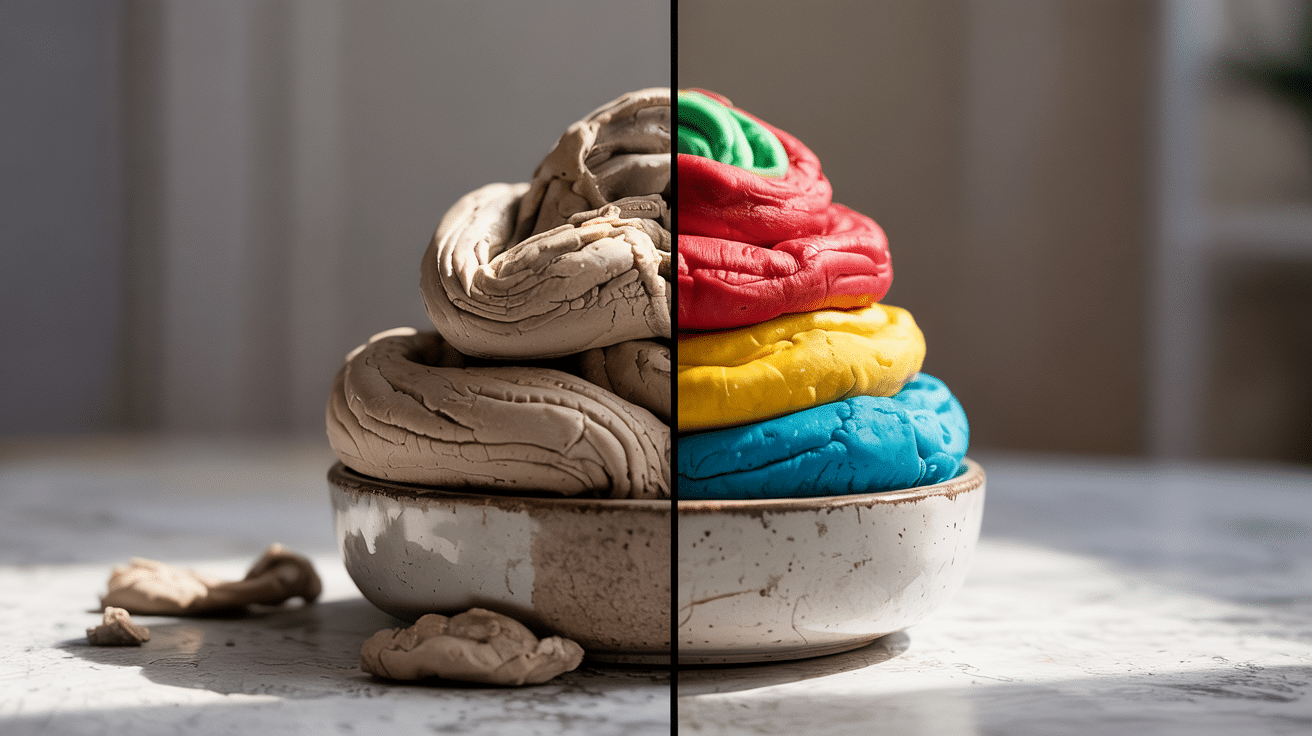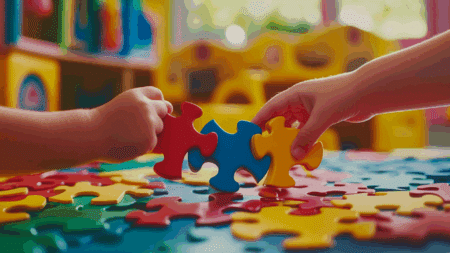Is your child’s playdough crumbling into bits? Nothing stops fun faster than dry, hard playdough that won’t mold or shape. Many parents toss it out, wasting money and creating more trash.
But wait – you don’t need to buy new playdough! With simple household items, you can make old playdough soft and pliable again. Your kids will thank you, and your wallet will too.
How to fix dry playdough isn’t magic; it’s science. The right amount of moisture and a bit of patience can bring those hard lumps back to life.
This guide shows you four tested methods to refresh dried-out playdough. These tricks work on store-bought and homemade varieties. Ready to turn that crumbly mess into hours of creative play?
Let’s get those little hands back to molding and creating!
The Science Behind Dry Playdough: What You Need to Know

Playdough dries out because water in the mixture evaporates over time. This happens faster when:
- You leave it out in open air
- The container isn’t sealed properly
- The room is hot or has low humidity
- Kids play with it for long periods
The basic make-up of playdough includes water, salt, flour, and oil. When water leaves, the salt crystals grow larger and the dough becomes hard and brittle. The texture changes from soft and stretchy to crumbly and stiff.
To bring it back to life, you need to add moisture without making it too sticky or wet. The key is balance – too much water makes a gooey mess, too little won’t soften it enough. You’ll also need to work the water in slowly for the best results.
How to Fix Dry Playdough: Simple Solutions
Here are four tested ways to bring your crumbly playdough back to life using items you already have at home:
Method 1: Water and Kneading

Materials needed:
- Dry playdough
- Small bowl of water
- Clean work surface
Instructions: Break the dry playdough into small pieces and place them on your work surface. Dip your fingers in water and gently pat the dough pieces. Start kneading the dough, adding tiny amounts of water as you go.
Keep working the dough with your hands. This may take a few minutes, so be patient. If it still feels dry, add a few more drops of water. Be careful not to add too much at once, or your dough will become sticky and runny.
Method 2: Sealed Bag Method

Materials needed:
- Dry playdough
- Spray bottle with water
- Zip-lock plastic bag
Instructions: Place your dry playdough chunks in a zip-lock bag. Spray a small amount of water into the bag – about 5-6 sprays should do for a standard ball of playdough.
Seal the bag tightly, pushing out excess air. Let it sit for 24 hours, turning the bag over a few times during this period. The next day, take out the dough and knead it until it reaches the right texture.
Method 3: Microwave Method

Materials needed:
- Dry playdough
- Microwave-safe bowl
- Damp paper towel
- Microwave
Instructions: Put the dry playdough in a microwave-safe bowl. Cover it with a damp paper towel to add moisture. Heat in the microwave for 5-10 seconds only.
Check the dough – it should feel warm but not hot. Take it out and start kneading. The heat helps the dough absorb moisture from the paper towel. If needed, repeat with a fresh damp towel, but be careful not to cook the dough.
Method 4: Oil and Water Mix

Materials needed:
- Dry playdough
- Small bowl
- Few drops of baby oil or vegetable oil
- Warm water
- Fork or spoon
Instructions: In a small bowl, mix a few drops of oil with a teaspoon of warm water. Break up your dry playdough into small bits and add them to this mixture.
Let it soak for about 10 minutes. Then, start working the liquid into the dough with your hands. The oil helps lock in moisture, making the dough stay soft longer after you fix it.
With these four simple methods, you now know exactly how to fix dry playdough without spending money on new supplies.
Fun Activities with Playdough for Kids

Now that your playdough is soft and pliable again, try these fun activities that will keep kids engaged and help them learn while they play.
Activity 1: Letter and Number Stamping
Help kids learn shapes, letters, and numbers by creating imprints in playdough.
- What you’ll need: Cookie cutters shaped as letters and numbers, rolling pin, flat surface, playdough in different colors.
- How to play: Roll out the playdough until it’s flat and smooth. Show children how to press the cookie cutters into the dough to make imprints. For older kids, challenge them to spell their names or make simple math problems. This helps with letter recognition and early math skills while they enjoy the sensory feel of the dough.
Activity 2: Mini Playdough Worlds
Create tiny worlds with themes like farm, ocean, or space to ignite interest.
- What you’ll need: Playdough in various colors, small toys like animals or people, twigs, pebbles, shells or other natural items.
- How to play: Start by making a base from playdough. Add hills, valleys, rivers or ponds using different colors. Place the small toys and natural items around to create a scene. Encourage the child to tell stories about their world. This builds language skills and creative thinking through open-ended play.
Activity 3: Playdough Pizza Shop
Turn playdough time into a pretend pizza restaurant for fun role-playing.
- What you’ll need: Brown, red, yellow and green playdough, plastic knife, small plate, rolling pin.
- How to play: Make a brown circle for the pizza base. Roll red playdough for sauce and add yellow cheese on top. Create green and other colored toppings. Kids can take turns being the chef and customer. They can cut slices and serve them. This game builds social skills, math concepts, and fine motor control.
Activity 4: Playdough Bug Hunt
Combine outdoor fun with creative play by making bugs from playdough.
- What you’ll need: Playdough, small sticks, grass, leaves, pictures of bugs or insects for reference.
- How to play: Look at bug pictures together or take a walk outside to spot real insects. Come back and use the playdough to make bugs, using sticks for legs and antennae. Add leaf wings or grass details. Talk about the parts of insects and how they move. This mixes science learning with art while improving finger strength.
Activity 5: Secret Treasure Hunt
Hide small valuables in playdough for a fun sensory search game.
- What you’ll need: A large batch of playdough, small washable toys, coins, or plastic gems.
- How to play: Hide the small objects in balls of playdough while the child isn’t looking. Give the child the playdough balls and have them squeeze, pull, and break them open to find the hidden items. You can make clues about what they’re looking for or count how many items they need to find. This builds patience and fine motor skills.
These activities not only make playtime more fun but also help extend the life of your playdough after you’ve learned how to fix dry playdough.
Wrapping It Up
Dry playdough doesn’t have to mean the end of creative play. The four simple methods shared here provide quick fixes using items most people already have at home. Parents can save money and reduce waste by knowing how to fix dry playdough instead of tossing it away.
The science behind these fixes is straightforward – replace lost moisture and lock it in. Whether using the water-kneading technique, sealed bag method, microwave trick, or oil-water mix, the result is the same: renewed, soft playdough ready for creative hands.
Remember to store playdough properly in airtight containers after play to keep it fresh longer.
Have you tried any of these methods? Try them out and share which one worked best for your dried-out playdough in the comments below!
Frequently Asked Questions (FAQ’s)
Is It Safe to Use Dry Playdough for Kids?
Yes, dry playdough is safe but not fun to use. It may crumble and cause small pieces that very young children could put in their mouths.
How Long Does Playdough Last Before It Dries Out?
Store-bought playdough lasts about 3 months with regular use before drying. Homemade versions typically dry out faster, often within 2-4 weeks.
How Can You Store Playdough Effectively?
Keep playdough in airtight containers or zip-lock bags with air removed. Store in a cool place away from heat. Wrap each color separately to prevent mixing.
Is Dry Playdough Biodegradable?
Most playdough is biodegradable since it contains mainly flour, salt, and water. Store-bought versions may take longer to break down due to added preservatives.




